Shep Hyken's Blog, page 65
April 26, 2022
Amazing Business Radio: Daniel Coyle
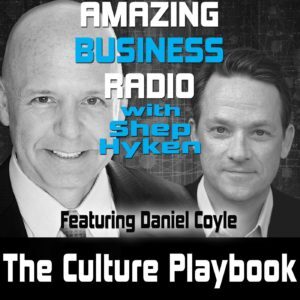 The Culture Playbook
The Culture Playbook How to Develop Workplace Culture Like a Skill
Shep Hyken interviews Daniel Coyle, New York Times bestselling author of The Culture Playbook: 60 Highly Effective Actions to Help Your Group Succeed. They discuss developing your team’s culture as a skill through consistent action, practice, and reflection.






 Top Takeaways:Culture is not about words. Culture is about actions and behaviours.We always think that culture is like the personality of a group. That’s not true. Culture is performance. It is when people act in such a way that contributes to the team’s performance.Daniel Coyle shares three tips (out of 60!) from his book, The Culture Playbook: The Culture Playbook: 60 Highly Effective Actions to Help Your Group Succeed.
Top Takeaways:Culture is not about words. Culture is about actions and behaviours.We always think that culture is like the personality of a group. That’s not true. Culture is performance. It is when people act in such a way that contributes to the team’s performance.Daniel Coyle shares three tips (out of 60!) from his book, The Culture Playbook: The Culture Playbook: 60 Highly Effective Actions to Help Your Group Succeed.Tip #1. Keep an open face. Our face is like a door. It has two settings, closed and open. Our face is closed when our thoughts are focused inwards. It is open when we communicate energy, interest, excitement, and enthusiasm.
Tip #2. The two-line email. Ask your employees to send you a two-line email with these prompts: Tell me one thing you want me to keep doing, and Tell me one thing you want me to stop doing.
Tip #3. AAR or After Action Review. AAR is a 5-minute meeting that has a massive impact on strength and performance. After you do something with your team, pause and ask these three questions: What went well? What didn’t go well? What are we going to do differently next time?
Daniel also shares more ideas about pillars of building culture, the subtraction game, and the benefits of “taking a pause” in this busy world. Tune in!Quotes:“Great cultures operate like a flock of birds in a forest. They stay connected. They self-organize to go past problems and move toward their goal.”
“Great culture happens when you pause, zoom out and answer these questions: Where are we going? How are we connecting? How are we interrelating? What does this mean?”
“All learning has two pieces: experience and reflection.”
“Good bosses signal their fallibility first. The four most important words a leader can say are “I screwed that up.”
About:Daniel Coyle is a New York Times bestselling author of The Culture Code, The Talent Code, The Little Book of Talent, The Secret Race, and Hardball: A Season in the Projects. His latest book is The Culture Playbook: 60 Highly Effective Actions to Help Your Group Succeed.
Shep Hyken is a customer service and experience expert, New York Times bestselling author, award-winning keynote speaker, and your host of Amazing Business Radio.
This episode of Amazing Business Radio with Shep Hyken answers the following questions … and more:
What is team culture?How do you develop a healthy culture in the workplace?What is After Action Review?Why is building relationships important in teams?How do you nurture group health?The post Amazing Business Radio: Daniel Coyle appeared first on Shep Hyken.
April 25, 2022
5 Top Customer Service Articles of the Week 4-25-2022
Each week I read many customer service and customer experience articles from various resources. Here are my top five picks from last week. I have added my comment about each article and would like to hear what you think too.
Consumers Prefer Traffic Jams Over a Bad Customer Experience by Retail Customer Experience(Retail Customer Experience) More than half, 60%, of consumers would rather sit in a traffic jam than have a poor customer experience, according to a Telus International survey. They also expect a faster, more intimate interaction and the option for automation technology, according to a press release on the findings.
My Comment: Let’s start this week’s roundup with a fun one. I love customer service statistics, and this short article has several. The headline is a fun one. Apparently, 60% of the consumers surveyed would rather sit in a traffic jam than have a poor customer experience. While there are some serious stats and facts in the article, the article closes with a fun one, which is that 27% identified Darth Vader as a fictional character most likely to provide the worst customer experience.
Top 10 Signs Your Loyalty Program Needs Rehab by Dan Jurek(CustomerThink) Customer loyalty best practices constantly evolve. So even if your program previously achieved great results, failing to update it frequently to keep customers engaged may mean you lose money, opportunities, or both. Consider these top 10 signs your brand’s loyalty program needs revision—plus some ideas about how to get it done.
My Comment: Next on our top 5 is a list of why your loyalty program might need an update. If you have a loyalty program, you will enjoy this list. One of the thoughts I had after reading the article was that loyalty programs are typically meant to get customers to come back. It doesn’t mean they are truly loyal, but they still come back, which is great. You want customers that keep coming back. Just understand why.
Customer Loyalty. Where Does The Contact Centre Agent Fit In? by Chris Wyper(ContactCentres) The pandemic had a significant impact on how we engage with brands, with nationwide lockdowns prohibiting face-to-face interactions and requiring both businesses and consumers to embrace digital alternatives. Now, as customers start to engage with brands more holistically again, interacting both in-person and virtually, organizations across all sectors need to ensure they are able to meet customer expectations at every touch-point to retain their customers.
My Comment: This is an excellent article that mirrors my philosophy that the customer service agent’s job is much more than just answering questions and solving problems. They are the front-line ambassadors of the company that help get customers to come back, generate revenue, and create raving fans.
Why the Next Big Marketing Opportunity is: In-App Customer Service by Eric Vermillion(MarTech Series) Good news: Customer service doesn’t have to be a battle of customer vs. company. Instead of treating customer service like an afterthought or an overhead cost, your company has an opportunity to turn customer service into a revenue generator and a strategy to create a long-lasting competitive advantage.
My Comment: This interesting article makes the case that a brand app is a great way to connect with your customer. When a customer takes the time to download an app, it’s a commitment. It shows interest and takes several steps to find the app in the “store,” download it, open it, log in, set up an account, etc. If they are willing to do that, there is obvious interest. Ultimately, according to the author, the app can become the “hub of your customer experience.”
These 5 Consumer Need States Are Your Path to Success by Amy Balliett(Inc. Magazine) What makes a brand essential? In today’s marketplace of infinite choice, you should assume that any brand is replaceable — yes, including yours. It doesn’t take much digging to find a competitor for consumers to send their business to. No Ubers available in the area? Consumers may turn to Lyft. That cup of Starbucks killing the pocketbook? Dunkin’ may start to gain appeal. With so many alternative providers, your brand’s relevance is always on the chopping block. So how is it that some brands manage to rise above the rest and maintain customer loyalty, time and time again?
My Comment: Every customer wants these five “consumer need states,” which is just a fancy way of saying “desires.” And these are not limited to retail consumers. B2B customers have the same needs/desires. This is not rocket science. These are the basics that all customers – of any type of business – want from the companies and people they do business with.
[image error]Shep Hyken is a customer service expert, professional speaker and New York Times bestselling business author. Go to The Customer Focus to learn more about our customer service training programs. Follow on Twitter: @Hyken
to learn more about our customer service training programs. Follow on Twitter: @Hyken
The post 5 Top Customer Service Articles of the Week 4-25-2022 appeared first on Shep Hyken.
April 22, 2022
Guest Post: The Intersection of Engagement and Productivity
This week, we feature an article by Luke Jamieson, Regional Director at Centrical, the next-gen employee engagement and performance platform. He writes about the importance of engagement and employee experience to an organization’s productivity to business success.
According to Gallup, highly engaged teams are 21% more productive. What’s the connection between engagement and productivity and how do you achieve this nexus?
Engagement and productivity are uttered almost daily in the business community. Most people understand they are related, but mistakenly think that the road between engagement and productivity is linear. In fact, they are part of a complex, interconnected web. Leaders and organizations that care about the performance of their companies need to care about engagement and employee experience (EX). They cannot focus single-mindedly on productivity without addressing the underlying factors. Leaders need to zoom out and look at the bigger picture that connects engagement to productivity to business success.
A virtuous cycle of employee engagementWhen the term “engagement” is used in the marriage context, it’s understood as a mutual promise and expression of intent. However, when it’s used in a work context, we often only consider one side—an employee is either engaged or not. But employee engagement is also two-sided. Employers have a responsibility to understand and focus on employee engagement.
It bgins by understanding what employee engagement looks like. The starting point for any company is enjoyment—employees need to like their work and enjoy what they do on a day-to-day basis. From there, it kicks off a virtuous cycle of employee engagement:
Employees who enjoy their work have a thirst for knowledge and are curious. Curiosity leads to greater knowledge and understanding. Increased understanding develops a sense of value for the knowledge. It is natural to care about what a person values. Care leads to pride in the work or company. Pride continues to increase enjoyment and continues the cycle.All of these factors work together to increase employee engagement by tapping into natural intrinsic motivators. When someone loves their work, they will naturally start diving deeper to learn more and develop that sense of value, care, and pride over their work.
Connecting the dotsEmployee engagement is a multi-faceted experience, as we’ve just seen. But, as it continues to run its own virtuous cycle, it begins to connect with productivity, customer experience, and business success.
An engaged employee has deep knowledge and understanding of their role, responsibilities, and the company’s products and services. Knowledge naturally increases the quality of work, efficiency, and productivity, as they are able to work more effectively.
Another intersection is by creating an excellent customer experience (CX). An engaged employee values and cares about their work, which will help them create a good CX because they are authentically seeking to help and serve customers. Excellent CX will lead to loyal customers and business success, but it will also develop a sense of pride for the employee, that they are part of a company that cares for customers well.
Increased productivity and strong CX will both lead to business successes. An effective leader will recognize all these intersections and understand the value of continuously reinvesting in employees. Creating a good EX is not a one-time thing but requires continual work and prioritization.
Join Shep online for The “X” Factor – Igniting CX Through Outstanding EX on Tuesday, April 26th at 11 AM EST / 3 PM GMT where he will talk about the intersection of CX and EX and how to power both. Shep will be joined by Sean Hammerle, COO of ONQ — a powerhouse contact center company specializing in healthcare and patient services and a Centrical client. Sean will share global insights into how his company is boosting EX through innovative and uniquely personalized engagement strategies and a culture that puts employees at the center of everything ONQ achieves.
Luke Jamieson is one of the top 25 global influencers and thought leaders on customer experience and employee engagement. He is a Regional Director at Centrical, the next-gen employee engagement and performance platform.
 For more articles from Shep Hyken and his guest contributors go to customerserviceblog.com.
For more articles from Shep Hyken and his guest contributors go to customerserviceblog.com.
Read Shep’s latest Forbes article: Is There Such A Thing As The Perfect Job?
The post Guest Post: The Intersection of Engagement and Productivity appeared first on Shep Hyken.
April 20, 2022
How to Deal with Customer Complaints: The Perfect Thing to Say
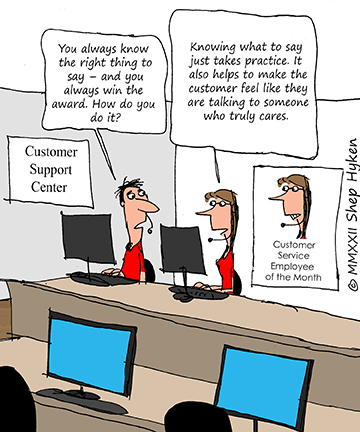 There are many ways to deal with complaints or angry customers. I’ve written a number of articles on the different ways to do so, and today I want to add an excellent technique.
There are many ways to deal with complaints or angry customers. I’ve written a number of articles on the different ways to do so, and today I want to add an excellent technique.
The idea is to say something that lets the customer know you understand the problem, you’re in sync with their concerns, and you empathize with their frustration, anger or whatever emotion they’re exhibiting. I refer to this as The Perfect Thing to Say.
This is more than apologizing and acknowledging the customer, which are steps one and two of my five-step process for dealing with angry customers. When a customer brings you a problem or has a complaint, you want to find a way to align with their goals and articulate it in such a way that immediately lets them know you are on their side. Let them know you’re in sync with them and what they want to achieve.
Here is a perfect example. I had switched to a new mobile phone. I was having great difficulty getting familiar with the new features. I wanted to return the phone and go back to the older technology. Actually, returning the phone wasn’t on my mind. I wanted to smash the phone and mail the pieces back to the manufacturer. It was that different. Eventually, my frustration forced me to call customer support. In just a short time, I was talking to a rep. I know he sensed my frustration, so I emphasized that I wasn’t angry at him but at the phone. After all, if he was there to help me, I didn’t want to make him angry.
Then the magic happened. Once he listened to my problems, making several comments that proved his empathy toward my situation, he said something that made me want to keep the new phone. He said, “I want you to love your phone so much that you’re willing to jump in front of a bus to save it.”
Trying to stay with his lighthearted comment, I replied, “I’d be happy to jump in front of the bus, as long as it was going backward.” But what I was really thinking was that this was a bigger challenge than he thought, and was he up for the task? Go ahead and give it your best shot.
Regardless of my frustration, I realized he was there to help me. His positive attitude and energy, along with his perfect thing to say, turned me from an upset customer into one who wanted to love his brand.
Think about the problems or complaints you hear most often. Is there a sentence or phrase you can work into the conversation that would turn that misery into magic? This isn’t something you make up on the spot. This is a line you will use again and again. It’s the line that will turn your angry customers into loyal customers who say, “I’ll be back!”
Shep Hyken is a customer service expert, keynote speaker, and New York Times, bestselling business author. For information on The Customer Focus customer service training programs, go to www.thecustomerfocus.com. Follow on Twitter: @Hyken
customer service training programs, go to www.thecustomerfocus.com. Follow on Twitter: @Hyken
(Copyright © MMXXII, Shep Hyken)
The post How to Deal with Customer Complaints: The Perfect Thing to Say appeared first on Shep Hyken.
April 19, 2022
Amazing Business Radio: Chris Lynam
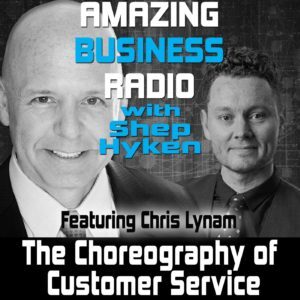 The Choreography of Customer Service
The Choreography of Customer ServiceThe 5 Core Concepts to Customer Service
Shep Hyken interviews Chris Lynam, Customer Service Expert and multi-franchise owner of Arthur Murray Dance Studios. He is the host of the podcast, Off the Floor, and the author of the new book, The Choreography of Customer Service: High Touch Service in a Touch-Free World. They discuss how your organization can implement the five core concepts of good customer service.






 Top Takeaways:Chris shares THE 5 CORE CONCEPTS TO CUSTOMER SERVICE from his book, The Choreography of Customer Service.The Backstory: Customer service professionals should discover what steps have led the customer to their business. Instead of asking, “How can I help you right now?” ask, “What has brought you in here today?” If customer service professionals know their customer’s backstory, they will be able to put themselves into their customer’s shoes. This is how they can provide the level of service that they would want themselves.The Negative: When you genuinely care for your customers, you will give them the “cautionary tale” when necessary. The most appropriate advice may not always be what the customer wants to hear. But, if it will give your customers the best outcome, you have to make sure they get the complete picture.The Secret Mission: There is something unique that differentiates you from others and will help you outperform what might be considered average in your field or industry.Muscle Memory: What attitudes and good habits developed over time come naturally to you as you serve your customers?Return on Investment: How do you measure the return of investment on the frontlines? The return on investment is not necessarily measured by dollars. It can be measured by customer behaviour. It can be a compliment or the customer coming back to do more business with you.Chris also talks about building your customer team like you are preparing for a bank heist. Tune in to find out what this means and if you should be preparing for your own “bank heist.”Quotes:
Top Takeaways:Chris shares THE 5 CORE CONCEPTS TO CUSTOMER SERVICE from his book, The Choreography of Customer Service.The Backstory: Customer service professionals should discover what steps have led the customer to their business. Instead of asking, “How can I help you right now?” ask, “What has brought you in here today?” If customer service professionals know their customer’s backstory, they will be able to put themselves into their customer’s shoes. This is how they can provide the level of service that they would want themselves.The Negative: When you genuinely care for your customers, you will give them the “cautionary tale” when necessary. The most appropriate advice may not always be what the customer wants to hear. But, if it will give your customers the best outcome, you have to make sure they get the complete picture.The Secret Mission: There is something unique that differentiates you from others and will help you outperform what might be considered average in your field or industry.Muscle Memory: What attitudes and good habits developed over time come naturally to you as you serve your customers?Return on Investment: How do you measure the return of investment on the frontlines? The return on investment is not necessarily measured by dollars. It can be measured by customer behaviour. It can be a compliment or the customer coming back to do more business with you.Chris also talks about building your customer team like you are preparing for a bank heist. Tune in to find out what this means and if you should be preparing for your own “bank heist.”Quotes:“A great team has symbiosis between different players. You need to be honest and transparent about each member’s strengths and limitations.”
“Feedforward instead of feedback. Instead of examining customer interactions after they happen, prepare your customer service team for different scenarios before they go out into the frontlines.”
“The biggest limitation of improving the culture of service on a team is not the people in it. It is how leaders perceive the importance of nurturing the necessary skills and attitudes needed to provide excellent customer service.”
About:Chris Lynam is a customer service expert and multi-franchise owner of Arthur Murray Dance Studios. He is the host of the podcast, Off the Floor, and the author of the new book, The Choreography of Customer Service: High Touch Service in a Touch-Free World.
Shep Hyken is a customer service and experience expert, New York Times bestselling author, award-winning keynote speaker, and your host of Amazing Business Radio.
This episode of Amazing Business Radio with Shep Hyken answers the following questions … and more:
What are the five core concepts of customer service?What is the ROI of customer experience?How do you measure the return of investment in customer service?What is muscle memory in customer service?What is the difference between feedback and feedforward?The post Amazing Business Radio: Chris Lynam appeared first on Shep Hyken.
April 18, 2022
5 Top Customer Service Articles of the Week 4-18-2022
Each week I read many customer service and customer experience articles from various resources. Here are my top five picks from last week. I have added my comment about each article and would like to hear what you think too.
Tracking Customer Experience? Measure Outcomes, Not Indicators by Mike Cooper(The Drum) Ask any brand to rate their customer experience on a scale of one to 10 and most will probably choose a high number. Now ask one of their customers, and they’ll probably give a different answer – a lower one too. This is the ‘customer experience gap.’ Trinity McQueen’s Mike Cooper, head of customer experience, considers the cause of this difference and how to work around it.
My Comment: This article starts with the premise that there is a CX gap, which is the difference between what brand executives and the brand’s customers think about the level of customer service and experience the brand provides. Often there is a “gap,” a difference that often indicates the executives just don’t know. The answer is to measure success in the right places, and the author offers up four in particular.
Product Drops Not Price Drops: Attracting Full-Price Customers In The Face Of Inflation by Dan Wallace-Brewster(Forbes) It’s easy for retail professionals to look at global, political and economic trends and say inflation is out of control and overgeneralize shopper behavior. Just because prices are going up doesn’t mean people who value convenience over cost are suddenly going to become bargain shoppers. Not every shopper falls neatly into one of two categories, and many have different behaviors for different product categories.
My Comment: This is an interesting article from the retail world where the author claims that in the midst of 7.5% inflation (or higher depending on your source of info), Americans can be divided into three groups: 1) convenience shoppers who value the experience over price and buy less than 40% of their purchase on sale, 2) bargain shoppers who buy more than 40%, and 3) part-tie bargain shoppers who fall in the middle. Understanding those groups and how to sell to them is important to the success of your business.
The Importance of Customer Experience Observability by Linda Chen(DevOps.com) Ask anyone to name their favorite brand, and they’ll often respond with minimal hesitation. Prod a little further and the importance of customer experience (CX) is sure to play a major role in their response. In fact, 96% of consumers say CX is a key factor in their choice of loyalty to a brand. This sentiment is even more powerful post-pandemic, with 58% of consumers saying they place more importance on CX when making purchasing decisions than they did pre-pandemic.
My Comment: This is a very technical article, but I found it fascinating as it introduced me to a concept called “observability,” which is an approach that collects and analyzes data on the system, especially anything that contributes to the digital customer experience. Gartner has identified observability as, “…the evolution of monitoring into a process that offers insights to speed innovation and enhance CX.”
Customer Understanding: Why Is It the Cornerstone of Customer-centricity? by Annette Franz(CX Journey) You can’t make any improvements, you can’t design an experience, you can’t transform anything, without customer understanding, without data and insights about your customers. You must first understand customers and their pain points, problems to solve, and jobs to be done. After all, who are you in business for?
My Comment: Annette Franz is the author of Customer Understanding and the recent book, Built to Win, which is about creating a customer-centric culture that drives value. In this article, she approaches a concept from both books, which is about customer understanding being the cornerstone of customer-centricity. Understanding the customer means, in Franz’s words, “No discussions, no decisions, no designs without bringing in the customer and her voice (that’s the understanding piece), without asking how it will impact the customer, how it will make her feel, what problems it will help her to solve, what value it will create and deliver for her.”
Why Customer Service is Important: 10 Reasons to Prioritize It by Erika Trujillo(The Groove Blog) Providing customer support can take up a lot of time and energy, which is why traditional customer service is often seen as a cost center. Company leaders know they need to provide service, but they see this as a “cost of doing business” rather than an opportunity to delight customers, make connections, and ultimately increase revenue.
My Comment: This is an excellent list of ten reasons you should be devoting more effort to customer service. Here are some great stats, facts, strategies, examples, and tips that will help any organization deliver a better customer service experience.
BONUSCheck Out These Retail Reads From Our Top Influencers by RETHINK Retail(RETHINK Retail) Looking for fresh retail perspectives? We curated a list of the best retail reads featuring RETHINK Retail’s Top Retail Influencers. Read countless insights from the best and brightest thought leaders with their fingers on the pulse of the industry.
My Comment: Even though the title indicates these books are “retail reads,” many are appropriate for any type of business. And thank you, RETHINK Retail for including my book, Cult of the Customer, on this excellent list!
[image error]Shep Hyken is a customer service expert, professional speaker and New York Times bestselling business author. Go to The Customer Focus to learn more about our customer service training programs. Follow on Twitter: @Hyken
to learn more about our customer service training programs. Follow on Twitter: @Hyken
The post 5 Top Customer Service Articles of the Week 4-18-2022 appeared first on Shep Hyken.
April 15, 2022
Guest Post: How to Create an Exceptional Customer Experience Strategy?
This week, we feature an article by Manpreet Chawla, senior digital marketing specialist at Knowmax, a knowledge base management solution for enterprises looking to provide exceptional customer experience to their customers via enhanced agent satisfaction. He shares how to create excellent customer experiences at every stage of the customer journey.
Every organization strives to create a customer experience strategy that provides it a competitive edge in the market and delivers maximum value and revenue for the business. Companies that take a people-centric approach to succeed in achieving greater profits and higher brand value in the long term.
Today, customers do not remember the prices they paid for a particular product as much as they remember the purchase experience. And given the endless options, they have today, creating valuable experiences is the only way businesses can truly succeed.
The idea behind building a great customer experience strategy is to achieve higher business growth through increased customer satisfaction. And customer satisfaction increases when they feel valued each time they interact with a brand and receive the same high-quality support at all times.
Thus, to maximize customer satisfaction, it is essential to have a holistic view of customer journeys and elevate experiences at every possible point of interaction.
Top 5 ways to create a robust customer experience strategy Automate customer serviceAs any business organization begins to expand its operations, serving every customer on a personal scale becomes difficult. And this is only natural, given the limits customer support representatives have with both time and energy. The key then is to go back to the starting point, which is your customers, take an extensive view of their needs, expectations, and grievances, and implement a solution that can fundamentally address these challenges.
Automating customer services is the way forward. It can ensure your customers get their answers at the right time and support teams function more effectively, building a truly people-centric organization. The idea is to not look at technology as a replacement for human potential but as a supplement to boost the efficiency of human resources.
Customer service automation increases customer satisfaction by enhancing the self-service capabilities of your organization. When customers have minor problems, they may feel more comfortable reading a short article instead of getting on a call with a support agent to find the answer. Knowledge base articles and FAQs should be drafted in a language that is easy for customers to grasp, along with the need to be updated timely to ensure customers receive the support they expect.
Make knowledge available across the organizationA big challenge faced by customer service teams is the inability to find the correct information at the right time. This is because much of the data is fragmented in different files and formats, and by the time an agent can collect the information, a lot of time is already gone by, resulting in a poor customer service experience. To deliver meaningful experiences to customers, you must ensure that all the information that people need in your organization is readily available and accessible at all times.
Implementing Knowledge management for customer experience can help you deal with your complex CX challenges by preventing data silos and organizing all information in one place. A centralized DIY knowledge base makes it easy for both your customer support teams and customers to find the information they need. Using semantic search, an AI-powered Knowledge base enhances the discovery of Knowledge even when the user query is misspelled as it understands the intent of the search.
Empower agents with the right customer support toolsAs customer expectations rise, you should ensure that customer support teams are equipped with upgraded support tools to meet their targets effectively. Not all customer problems can be resolved with the information contained in long text documents. Moreover, it is impossible to remember how a particular customer query was fixed at a point in time since multiple steps are involved. The key then is to standardize the ways customer support representatives approach customer queries to avoid inconsistency in the resolution process.
Upgraded call center scripting with AI empowers agents to communicate effectively with customers. An AI-enabled customer support tool, Cognitive Decision Trees, guides agents with the next best action while troubleshooting customer problems.
Not only do Cognitive Decision Trees enable agents to solve more support tickets, but they also ensure that all the agents follow all the steps in the correct order, resulting in improved SOP adherence.
Improve customer experiences with an integrated channel approachA great Customer experience strategy depends on how easy you could make it for your customers to complete their purchases, answer their questions and avail your customer support services. To delight customers, it is crucial to track their journey and ensure seamless experiences.
A customer may choose to switch between channels for a particular issue. Providing an integrated channel approach connects all the platforms and ensures customers experience a seamless transition across platforms. A customer switching from a chatbot to a phone call would not be required to repeat the problem from scratch as the agent receives all the information from where the customer left.
Providing omnichannel customer support ensures customers receive adequate and consistent quality support throughout their journey, irrespective of the platform they use.
Incorporate feedback to optimize customer supportIt is essential to learn from the experiences of customer support agents and provide them with convenient ways to share their concerns. Agent feedback provides actionable insights, helping enhance the visibility of the most engaging content and adding new information timely. The quality of customer support services improves significantly when people are encouraged to become active participants in the decision-making process.
ConclusionA great customer experience strategy depends on the ability to collect, organize, manage and share knowledge within and outside the organization. If employees are well aware and find it easy to access information, they feel more confident about their work and deliver adequate support to customers.
The availability of efficient and upgraded customer support tools improves the ways people engage with data in an organization, helping support teams to share meaningful experiences with customers.
Manpreet Chawla is a senior digital marketing specialist at Knowmax, a knowledge base management solution for enterprises looking to provide exceptional customer experience to their customers via enhanced agent satisfaction.
 For more articles from Shep Hyken and his guest contributors go to customerserviceblog.com.
For more articles from Shep Hyken and his guest contributors go to customerserviceblog.com.
Read Shep’s latest Forbes article: How To Beat The Stock Market By Four Times
The post Guest Post: How to Create an Exceptional Customer Experience Strategy? appeared first on Shep Hyken.
April 13, 2022
The Day I Became a Customer Service Expert and Two Important Lessons
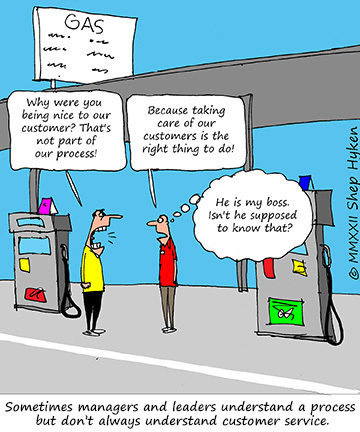 “Find a job you love, and you’ll never work a day in your life.”
“Find a job you love, and you’ll never work a day in your life.”
This line has been credited to Confucius, Mark Twain, Mark Anthony and others. Anyone who finds what they love to do at work, either through a passion, hobby, interest, a random job they end up loving, or some defining moment is lucky. That makes me one of the lucky ones. Just out of college I started my career as a customer service expert. It wasn’t a random job I applied for. It was a chosen profession that had its roots in something that happened to me when I was younger, an event that caused me to become obsessed with customer service.
I’ve written about being a 12-year-old birthday party magician when my parents taught me some basic customer service lessons. Show up on time, say thank you, follow up to get feedback, and a few other important lessons that any and every business should practice. These lessons laid the foundation that ignited my passion for customer service. Then something happened eight years later while I was in college and working at a gas station, which is when I discovered that I was passionate about customer service.
The right thing to doI was working at a self-service gas station. We didn’t accept credit cards, so when customers finished filling up their tanks, we would go to their car, take their money and make the appropriate change.
On one very, very cold day, I offered to help an elderly lady pump the gas for her car. I told her to stay in the warm car. She appreciated my assistance, but my manager didn’t. When I came inside, he yelled at me for helping her and emphasized the meaning of a self-service gas station. I defended my position. The lady was old and frail. It was the right thing to do!
He said, “Now she’s going to expect that the next time she comes back,” to which I replied, “I hope she does come back, instead of going to the station across the street or on the opposite corner.” He gave me an angry look and slammed the door as he walked out of the building.
That was a defining moment. It was the right thing to do, and more importantly, I liked how it felt. I recognized this intense desire to take care of customers, eventually causing me, less than a year out of college, to teach others to do the same.
Decades later, I think back to this experience and can spot two lessons that are very important to every business: Some people are passionate about customer service. They love taking care of people, solving their problems, and turning negatives into positives. These are the people you want to hire to be on the frontline of your business. (By the way, I am one of those people.) The title of manager, supervisor, or any other type of leader doesn’t mean the person knows how to take care of customers, let alone has a passion for doing so. It is frustrating when “the boss” doesn’t understand the people side of the business. If all they are focused on is the process or the bottom line and they don’t take their employees and customers into consideration, you’ll have a well-run business that loses to a competitor who creates a better customer experience.The point is that if you want your organization to be customer-focused, you must find the right people to run, manage and work for the company. In a perfect world, you’ll find people who have a passion for doing so. And if you ask them how they feel about the saying, “Find a job you love, and you’ll never work a day in your life,” they will say, “That’s me!”
Shep Hyken is a customer service expert, keynote speaker, and New York Times, bestselling business author. For information on The Customer Focus customer service training programs, go to www.thecustomerfocus.com. Follow on Twitter: @Hyken
customer service training programs, go to www.thecustomerfocus.com. Follow on Twitter: @Hyken
(Copyright © MMXXII, Shep Hyken)
The post The Day I Became a Customer Service Expert and Two Important Lessons appeared first on Shep Hyken.
April 12, 2022
Amazing Business Radio: Dorian Stone
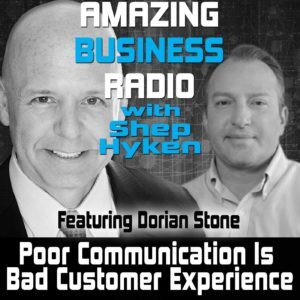 Poor Communication Is Bad Customer Experience
Poor Communication Is Bad Customer Experience How Communication Affects the Employee and Customer Experience
Shep Hyken interviews Dorian Stone, Head of Organizations Revenue of Grammarly Business. They discuss how communication affects an organization’s productivity, experience, and revenue.






 Top Takeaways:Communication is part of the experience. If you don’t communicate well with your customers and employees, you are giving them a bad experience.The Harris Poll research estimates that US businesses are losing $1.2 trillion annually due to poor communication.Dorian Stone shares what organizations can do to improve communication and experience for employees and customers. Do the math on how much time employees spend on written communication. Most knowledge workers, such as chat agents and email support agents, spend about half of their workweek writing into a system (chat, email, CRM, etc.). Reduce the time they spend writing by helping them eliminate errors, reduce rework, and maintain the appropriate tone through a writing assistant. Look at the English as a Second Language (ESL) versus English First Language mix of your business and then understand the dynamics. Examine the makeup of your workforce and see what your employees are working on. Evaluate how natural and consistent that communication flow is across all teams. Look at where you’ve made your recent investments. Ask yourself how much safety valve investments are there to avoid errors versus how many are really about throughput. Invest in systems that make things efficient and easy for your employees.Quotes:
Top Takeaways:Communication is part of the experience. If you don’t communicate well with your customers and employees, you are giving them a bad experience.The Harris Poll research estimates that US businesses are losing $1.2 trillion annually due to poor communication.Dorian Stone shares what organizations can do to improve communication and experience for employees and customers. Do the math on how much time employees spend on written communication. Most knowledge workers, such as chat agents and email support agents, spend about half of their workweek writing into a system (chat, email, CRM, etc.). Reduce the time they spend writing by helping them eliminate errors, reduce rework, and maintain the appropriate tone through a writing assistant. Look at the English as a Second Language (ESL) versus English First Language mix of your business and then understand the dynamics. Examine the makeup of your workforce and see what your employees are working on. Evaluate how natural and consistent that communication flow is across all teams. Look at where you’ve made your recent investments. Ask yourself how much safety valve investments are there to avoid errors versus how many are really about throughput. Invest in systems that make things efficient and easy for your employees.Quotes:“Poor communication is a frustrating productivity issue. Tasks have to be done twice when communication is ineffective.”
“Ineffective communication deteriorates the customer experience and business performance.”
“Poor communication frustrates employees just like it frustrates customers. Providing tools that will help employees communicate effectively will help make their jobs easier.”
“Organizations need to be thoughtful about the increasing demands on managers and employees in remote work and hybrid work models to maintain effective communication.”
About:Dorian Stone is Head of Organizations Revenue of Grammarly Business, overseeing all operations for the integrated business solution. Previously, Dorian was VP of customer experience strategy and marketing at Medallia. He was also a co-founder and leader of McKinsey & Company’s Global Customer Experience practice and a program director and volunteer in the Peace Corps.
Shep Hyken is a customer service and experience expert, New York Times bestselling author, award-winning keynote speaker, and your host of Amazing Business Radio.
This episode of Amazing Business Radio with Shep Hyken answers the following questions … and more:
What are the effects of poor communication in a workplace?How can communication be improved in customer service?How can you reduce rework and increase productivity in client-facing communication?Why is communication important to the customer experience?How do you equip teams to have effective and consistent communication?The post Amazing Business Radio: Dorian Stone appeared first on Shep Hyken.
April 11, 2022
5 Top Customer Service Articles of the Week 4-11-2022
Each week I read many customer service and customer experience articles from various resources. Here are my top five picks from last week. I have added my comment about each article and would like to hear what you think too.
Your Loyalty Program Might Be Losing You Money by Raghuram Iyengar, Young-Hoon Park, and Qi Yu(Harvard Business Review) In February 2020, Panera Bread announced the Unlimited Sip Club and rocked the coffee world. For just $8.99 a month, members could get unlimited refills of their favorite coffee or hot tea at any Panera location. With the average American consumer spending more than $2,000 a year on coffee, this sounded like an incredible deal for coffee drinkers — begging the question, how could Panera possibly justify such generosity?
My Comment: I’ve written that many loyalty programs are actually discount programs. What happens when the discounts are so big that a company loses money? Or, do they? The article starts with a short case study of Panera which offered all their “Unlimited Sip Cup” to their “members” for $8.99/month. That’s all the coffee you can drink. When the average person spends $2,000/year, this is a no-brainer bargain. But how does that bargain impact revenue and profits?
What’s Your Training Schedule? by Josh Linkner(Josh Linkner) Professional athletes achieve at the highest levels by spending 90% of their time training and 10% of their time performing. In most areas of life, however, we do the exact opposite. In fact, most business leaders, parents, and professionals spend closer to zero percent of their time in thoughtful study of their craft or training for improvement. Instead, we labor through the days in full-exertion mode and then wonder why we fail to reach our full potential.
My Comment: When it comes to customer service, I believe everyone must be properly trained – not just the front-line/customer-facing employees. Furthermore, training isn’t something you did, it’s something you do. This short article isn’t specifically about customer service training but about how often you should do training in any area of business.
Anytimed by Seth Godin(Seth’s Blog) It’s not a word, but perhaps it should be. If a competitor goes after your customers by offering them faster service, all day and all night, you’ve been anytime.
My Comment: It will take you 30 seconds (or less) to read this article, which is about a made-up word, “anytimed.” Since I don’t want my description to be longer than the article, I’ll stop here. (Yes, it’s the article is that short!)
Employee Engagement vs. Employee Experience: What’s the Difference & Why it Matters by Luke Jamieson(LinkedIn Pulse) Employee engagement, workplace culture, employee experience… these are popular captions that show up frequently in conversations about the current and future state of work. Especially given how the pandemic has radically shifted our work world, they’re important topics to talk about.
My Comment: This excellent article shares some definitions and differences between employee experience (EX) and employee engagement. It’s the experience that drives engagement. The author shares, “Employee experience happens to you; Engagement is within you. Experience is the journey, and engagement is the destination.
Winning on Purpose: 4 Lessons from Customer Loyalty Guru Fred Reichheld by Liam Burns(Medallia) In his new book, Winning on Purpose, Reichheld demonstrates that the primary purpose of a business should be to enrich the lives of its customers. Why? Because when customers experience that sentiment, they’re more likely to return and bring new customers with them.
My Comment: Anytime Fred Reichheld, the guru behind NPS (Net Promotor Score) has something to say, I listen. And here are four short customer loyalty lessons you can’t ignore. Pay attention to number four, where Mr. Reichheld claims that NPS is used incorrectly 90% of the time! If you like what you read here, check out my interview with Fred Reichheld on Amazing Business Radio.
[image error]Shep Hyken is a customer service expert, professional speaker and New York Times bestselling business author. Go to The Customer Focus to learn more about our customer service training programs. Follow on Twitter: @Hyken
to learn more about our customer service training programs. Follow on Twitter: @Hyken
The post 5 Top Customer Service Articles of the Week 4-11-2022 appeared first on Shep Hyken.



